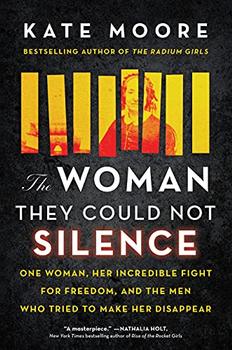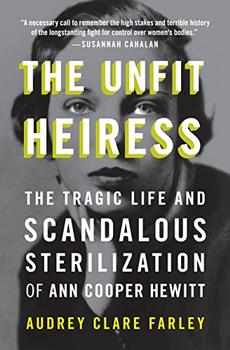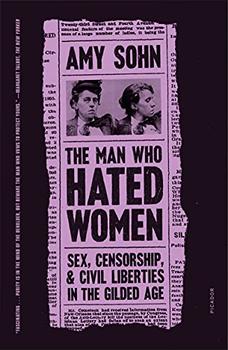Summary | Excerpt | Reading Guide | Reviews | Beyond the book | Read-Alikes | Genres & Themes | Author Bio

One Woman, Her Incredible Fight for Freedom, and the Men Who Tried to Make Her Disappear
by Kate MooreThe Woman They Could Not Silence by Kate Moore is a poignant and stark reminder of the importance of ethical mental health treatment, the dangers of oppression and the precarity of women's rights in a not-so-distant past. Using a combination of diary entries, historical research, letters and other written correspondence, Moore brings us the true account of social and legal reformer Elizabeth Packard.
For 21 years, Elizabeth and her Presbyterian pastor husband, Theophilus, appeared to live together peacefully, if not happily. They had six children whom Elizabeth described as, "the sun, moon, and stars." Motherhood was her first and truest love. She dedicated her life to making sure her children's world was as "wonderous" and perfect as possible.
However, even before the horrifying events that led to her being institutionalized, Elizabeth had begun to recognize her husband as a despotic man. Aside from controlling her time and actions, Theophilus would steal her belongings, destroy correspondence from her friends and family, and deny her access to money brought into the marriage by her father. For many years, Elizabeth viewed her marriage as more of "a cage" than a relationship of care and protection.
After a move from Massachusetts to the Midwest, Elizabeth felt inspired by the wide-open land to express herself more freely. She spoke her mind on matters considered "too important" for a woman, and communicated ideas and opinions contrary to her husband's. She questioned his rules for their children and his control over her choice of friends. She supported the burgeoning women's suffrage movement. It wasn't long before any façade of a peaceful marriage began to crumble.
After Elizabeth publicly challenged her husband's views during a Bible class in his church, Theophilus decided that his wife was "officially" insane and began the frighteningly simple process of having her committed to an asylum. On the morning of June 18, 1860, at the direction of her husband, several men from the community broke into Elizabeth's locked bedroom with an ax. She was forcibly removed from her home without even being given the chance to say goodbye to her children, dragged onto a train and, eventually, taken to Jacksonville Insane Asylum.
Jacksonville Asylum was run by Dr. Andrew McFarland. When Elizabeth first arrived at the asylum, she found McFarland attractive and kind. She believed she could easily convince him of her rationality and sanity. However, he ran the institute more like a prison than a hospital. He allowed husbands to have the final say on their wives' mental state, and often operated in concert with them, securing the ability to experiment on and study women while charging their spouses as much money as possible.
After no small amount of effort, including years of calculated resistance and a copious amount of notes on her experiences, Elizabeth was finally able to meet with the asylum's Board of Trustees and secure her release. Later, she would use those same notes to have herself legally declared sane, and to successfully fight for changes in legislation regarding institutionalization and the treatment of women.
Throughout the book, there is a disturbing similarity between the bystanders of Packard's time and those of today, especially pertaining to domestic abuse and harassment of women by men in power. Readers will also be able to locate clear parallels between measures used to certify a woman "insane" in the 1800s and the standards and expectations used against women now regarding appearance, age and intelligence. As noted in the book, a woman at the time could be institutionalized based solely upon her pallor, a button being undone, a hair being out of place or any manner of "unkempt appearance." Today, women are still battling gender-based judgments having to do with body shape and size, signs of aging, make-up use, hairstyles, fashion, etc.
Moore's research and dedication to the accuracy of events is obvious in her details of trial transcripts, letters and histories. Her writing is both straightforward and descriptive, allowing the reader to feel fully immersed in the time period and Elizabeth's emotions. The number of details and the author's frequent use of descriptive metaphors does slow the pace of the story somewhat. However, readers will likely come away from the book feeling thoroughly educated on the events portrayed.
While The Woman They Could Not Silence is an account of what happened to Elizabeth Packard in the 1800s, its messaging around equality, empowerment and the dangers of allowing only one group of people to maintain societal control is timely. It is the story of one woman, but it represents the oppression and abuses of countless others in the time of coverture (see Beyond the Book). It also provides women today with a heartbreakingly accurate though ultimately inspiring history of issues of equality and objectification.
![]() This review was originally published in The BookBrowse Review in July 2021, and has been updated for the
March 2022 edition.
Click here to go to this issue.
This review was originally published in The BookBrowse Review in July 2021, and has been updated for the
March 2022 edition.
Click here to go to this issue.

If you liked The Woman They Could Not Silence, try these:

by Audrey Farley
Published 2023
For readers of The Immortal Life of Henrietta Lacks and The Phantom of Fifth Avenue, a page-turning drama of fortunes, eugenics and women's reproductive rights framed by the sordid court battle between Ann Cooper Hewitt and her socialite mother.

by Amy Sohn
Published 2022
The New York Times–bestselling author Amy Sohn presents a narrative history of Anthony Comstock, anti-vice activist and U.S. Postal Inspector, and the remarkable women who opposed his war on women's rights at the turn of the twentieth century.
I always find it more difficult to say the things I mean than the things I don't.
Click Here to find out who said this, as well as discovering other famous literary quotes!
Your guide toexceptional books
BookBrowse seeks out and recommends the best in contemporary fiction and nonfiction—books that not only engage and entertain but also deepen our understanding of ourselves and the world around us.